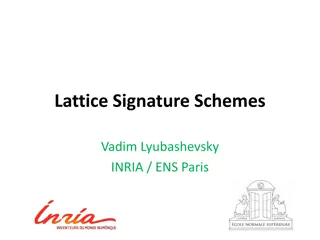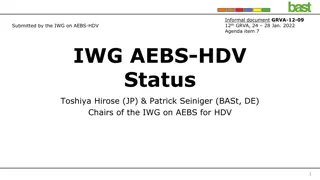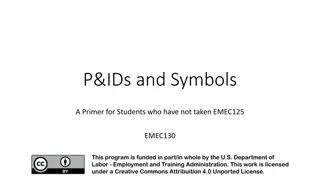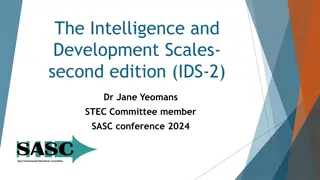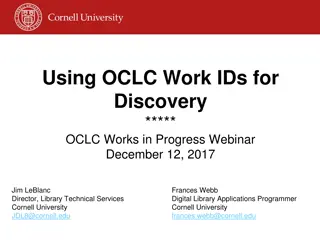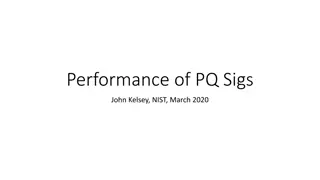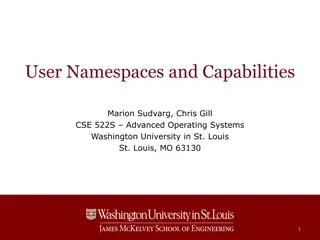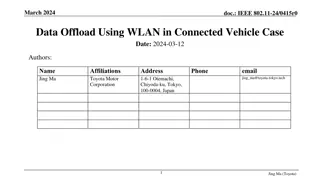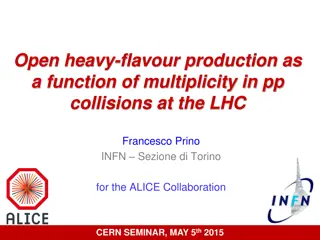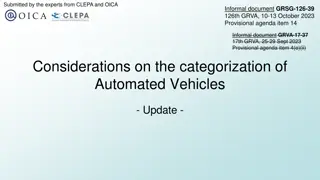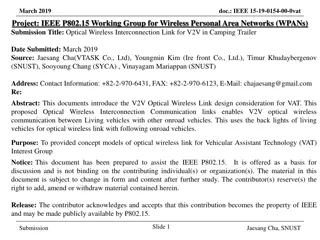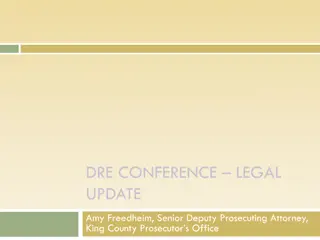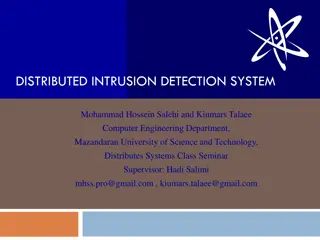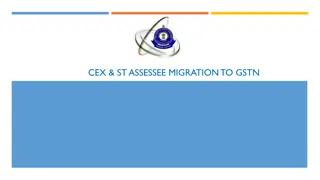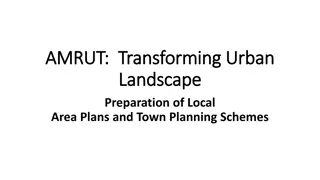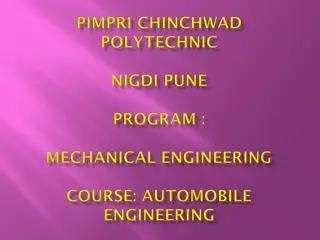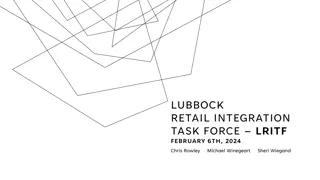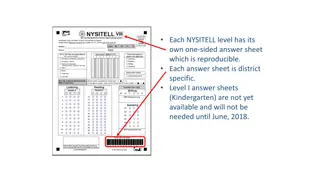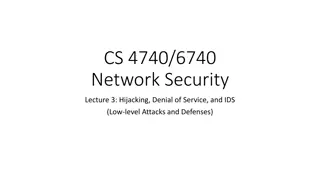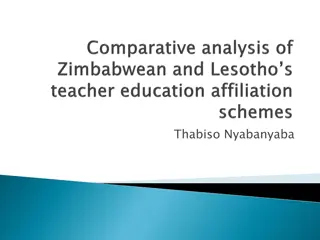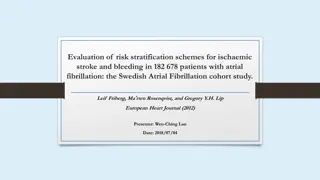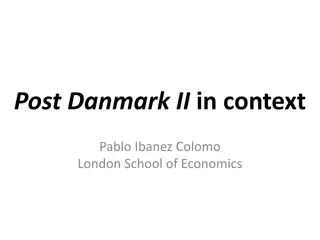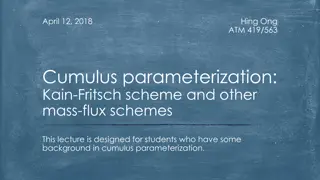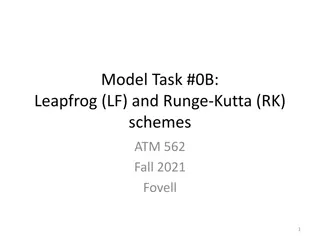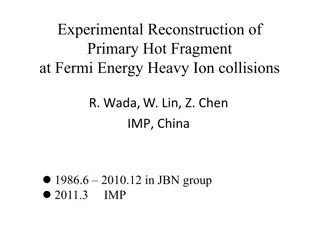Signature-Based IDS Schemes for Heavy Vehicles
This research focuses on developing signature-based Intrusion Detection System (IDS) schemes for heavy vehicles, particularly targeting the Controller Area Network (CAN) bus. The study delves into various attack vectors and payloads that have targeted commercial vehicles over the years, proposing the idea of utilizing existing attack signatures to design rules for detecting anomalies in CAN traffic. By understanding the composition and interpretation of messages in vehicular communications, the study aims to enhance security measures by implementing a signature-based IDS system for J1939-based systems. The pros and cons of this approach are discussed, emphasizing the importance of real-time detection with minimal distraction for drivers.
Download Presentation

Please find below an Image/Link to download the presentation.
The content on the website is provided AS IS for your information and personal use only. It may not be sold, licensed, or shared on other websites without obtaining consent from the author. Download presentation by click this link. If you encounter any issues during the download, it is possible that the publisher has removed the file from their server.
E N D
Presentation Transcript
Towards Signature-Based IDS Schemes for Heavy Vehicles Noah Cain, Subhojeet Mukherjee
The Big Picture Signature Database PENJ1939 1. The CAN bus in passenger and commercial vehicles has been intruded into. a. Make the ECUs obey commands b. Disrupt communication. c. Leading to grave consequences. Different attack vectors and payloads, since 2005. a. The Miller and Valasek jeep exploits from DEF CON 2013 b. Mukherjee and Burakova introduced newer ones on commercial vehicles Can we make use of the existing attack signatures to design rules that be evaluated against CAN traffic to deterministically flag an attack? 1. 2. Send Connect Send Decreased Message Size in ACK .. Your Friendly Neighbourhood Mr. SigIDS 3. 2. 3.
In-Vehicular Communications Messages composed at the Application layer. Contain state information RPM, ambient temperature, brakes pressed etc. Transmitted as sequence of bits on the CAN bus Bundled into J1939 PDU/ CAN Frame Instrumen t Cluster Cab Engine Controlle r ECUs receive, interpret and use messages Eg. RPM displayed on the dash
J1939 Message Interpretation CAN frame is obtained start-of-frame and end-of-frame bits are used. CAN specific bits are removed to obtain a J1939 PDU PDU has a 29 bit identifier and 64 bits data Parameter Group Number (PGN) is obtained. Eg. PGN 64993 from the example above. Associated Suspect Parameter Numbers (SPNs) are obtained from J1939 Digital Annex. Eg. SPN 2609, SPN 7853 SPNs bits extracted using Length and Starting bit position SPNs interpreted using Resolution and Offset. SPN 2609 [Cab/AC Refrigerant Compressor Outlet Pressure] -> 011001002*1610+ 010-> 100*16 -> 1600 kPa.
Attacks in a Nutshell [J1939 specific and CAN->J1939] 1. Reconnaissance a. Interpret protocol workflow Already public for J1939 Interpret triggers An ECUs response to a particular command Interpret proprietary information Very little to infer Personal Information a. Phone numbers, destination etc. ECU diagnostics a. Firmware info, fault codes etc. 1. Overload bus Overload ECU Disrupt protocol b. Inject string of 0 s. 2. Exhaust buffer with requests. c. 3. Claim all connections to prevent multi-packet message transfer. 2. 3. 1. 2. Changing message on the fly is difficult due to timing constraints. Spurious messages can be injected a. Snoop in and alter protocol workflow. Eg. Alter message size in buffer allocation message. Hijack address claim to masquerade ECU. b. Command ECUs Eg. Command high RPM to an ECU. Spoofing dash values. Signature IDS
Signature-based IDS for J1939-based Systems : Pros and Cons Cons Pros 1. Speed of detection a. In-vehicular IDS has real-time requirements. Less distraction for drivers a. False positive rate is expected to significantly lower. Ahead of anomaly or specification based detection a. Detecting those attacks which abide by all specifications. b. Significantly lower false-positive rates 1. Sig-database needs to be updated. a. If database is public, it needs to sync with in-vehicle detection unit. 0-day detection will fail a. Newer DOS techniques might succeed. Early research on CAN security have advised against it a. Mutter (2009), Hoppe(2008) b. Situation is still almost the same. 2. 2. 3. 3.
The Challenges Signature Database PENJ1939 1. How does Mr. SigIDS know what to look for? a. Need rules. Eg. i. Look for a string of 64 0 s in a packet. ii. Look for a bad packet size after connection initiation. How does Mr. SigIDS interpret a rule? a. Need a formal language. i. Binary operators:- AND, OR ii. Standard terminology and constructs. iii. Regex based filtering maybe!! b. Addressing packet level details:- ID, PGN, SPN etc. c. Need to be stateful i. If connection init was seen, and buffer size was agreed upon, new buffer size < original buffer size is buffer-overflow ATTACK!!. Where does Mr. SigIDS find the signatures? a. Publicly accessible signature database i. Pen J1939 [ACM CCS 17] How does Mr. SigIDS execute rules? a. Sniffing engine b. Signature Engine Where should Mr. SigIDS be deployed? 1. 2. Send Connect Send Decreased Message Size in ACK .. 2. Your Friendly Neighbourhood Mr. SigIDS 3. 3. 4. 5.
Presentation Outline 1. Is there an existing technology which does something similar in the CAN domain? a. No. 2. How about the IP domain? a. SNORT, in the IP domain b. Can we customize SNORT to fit the CAN domain? 3. What does CAN specification-based IDS literature suggest? a. Can we use some terminologies as primitives? i. Eg. msg.transmission_rate > 100ms b. Can we use some operators these authors have used/introduced? i. Eg. msg[ msg connection buf_size>100] c. What about time-based ordering for stateful detection? Noah I
Snort: IDS/IPS for TCP, UDP, ICMP, and IP Detection rules in Snort form a flexible language, generically of the form: action proto src_ip src_port direction dst_ip dst_port (options) Where action can activate another rule, drop-and-log the suspect packet, send an email alert to an administrator, or anything else it can even run other programs if necessary. Options are additional filters, allowing for finer-grained control over which packets do or don t trigger actions.
So what does an actual Snort rule look like? alert tcp any any -> any any (msg: Sample alert ;) Sends an alert on any tcp packet. alert tcp $EXTERNAL_NET any -> 129.82.0.0/16 80 (msg: Sample alert ;) Sends an alert on any tcp packet sent from an address matching the variable $EXTERNAL_NET to CSU on port 80 Rules are capable of even more flexibility with actions which wake up other rules!
Dynamic rules? Yes! One rule can wake up another! activate tcp any any -> 192.168.1.21 22 (content:"/bin/sh"; activates:1; \ msg:"Possible SSH buffer overflow"; ) dynamic tcp any any -> 192.168.1.21 22 (activated_by:1; count:100;) This pair of rules would start recording packets after a packet with payload containing the string /bin/sh was sent to address 192.168.1.21 on port 22.
Ok, but how does Snort filter against packet bodies? The simplest and fastest way is with a rule that has a content option. There are several modifier keywords for the content option, including: rawbytes (compare against the binary packet content without decoding) nocase (compare against packet contents without regard for case) offset (specify where in the packet body to start searching) within (specify a distance from a previous match to continue inspection) Slower approaches include the perl-compatible regex matcher or even comparing hashed contents of packets.
Snort Rule Quirks Syntax checking is complicated. Other tools exist for verifying the validity of a ruleset, like dumbpig: https://github.com/leonward/dumbpig Rules can include (Perl-compatible) regex-based packet matching with the pcre option, allowing extremely precise filtering of payloads Rule order matters: a packet is matched down the list, one rule at a time, until Snort finds a rule saying what to do with THIS packet. Rules are ordered (by default) in the sequence Alert, Pass, Log , which is to say that Alert rules are checked before Pass rules, which are in turn checked before Log rules. Usually, rule lists are obtained from a third party because it s easy to write a bad Pass rule. Rules need to be specific! Find the truffles amid the traffic.
But trucks dont use TCP, UDP, ICMP, and IP! Snort is open source, and the IP rule engine could reasonably be adapted to the CAN protocol, while TCP or UDP could be adapted to higher-level layers of the protocol stack, depending on the need to preserve state. Significantly, Snort is capable of tracking TCP state with the flowbits rule option: flowbits:<keyword>[bits/bats>],[<GROUP_NAME>]; bits ::= bit[|bits] bats ::= bit[&bats] https://www.snort.org/faq/readme-flowbits
Customizing SNORT to Suite J1939-Based Networks 1. Convert TCP/IP- based keywords and constructs into J1939 standards a. Thankfully SAE J1939 protocol stack is modelled on the ISO/OSI 7 layer model. Need for logical operators and existential quantifiers. a. Write complex rules. Train/Program the SNORT engine to understand the new constructs. Add a data interpreter module to the SNORT engine a. Allows matching to ID constructs:- PGN, Destination Address, Source Address etc. Eg. i. activate connection_protocol any -> Engine (content:"PGN:61441"; activates:1; msg:"Possible buffer overflow"; ) b. Allows matching to Data constructs:- SPN, values Eg. i. activate command any -> Engine (content: SPN_0:3000"; activates:1; msg:"Possible high RPM injection"; ) Include STATEFULNESS, based on previous or upcoming messages a. activate request_protocol any -> Engine (content: SPN_597:01"; previous: SPN_0:3000 activates:1; msg:"Possible high RPM injection while brakes pressed"; ) Train DUMBPIG to verify rules written for the J1939 based SNORT 2. 3. 4. 5. 6.
Some Efforts in Formally Specifying ECU Operation Standards 1. An Approach to Specification-based Attack Detection for In-Vehicle Networks Larson, Nilsson, Johnsson (2008 IEEE) a. msg [ msg SYNC.request CUR.time >= PREV.time + ECU.objdir(1006h)] b. Useful on a host based IDS c. If messages are identified uniquely (they are in J1939) these constructs can be useful. d. Does not address the statefulness property fully i. What if we need access to history beyond PREV? Using Semantic Technologies to Mine Vehicular Context for Security , Narayanan, Mittal, Joshi (2016 IEEE) a. hasComponent (vehicle, distanceSensor) hasStateValue (vehicleSpeed, high )........ b. Not as flexible as above. c. Single message based, can be adapted to stateful if messages are buffered. Defensing Malicious Attacks of Vehicular Network in Runtime Verification Perspective , Zhang, Feng, Wang (2016 IEEE) a. Suggest using Uppal to design Finite Automata b. Can be very useful in maintaining state c. Can be computation + space intensive on the detection unit 2. 3.
Deployment Specifics An extra ECU on the network Will not hinder ECU response time Deterrence will be difficult Host based detection Possible deterrence ECU response time might be slower Fleet management Human intervention might not be required for Signature based IDS, so this might be an overkill Slow Deterrence will need remote access.
Thoughts ??


